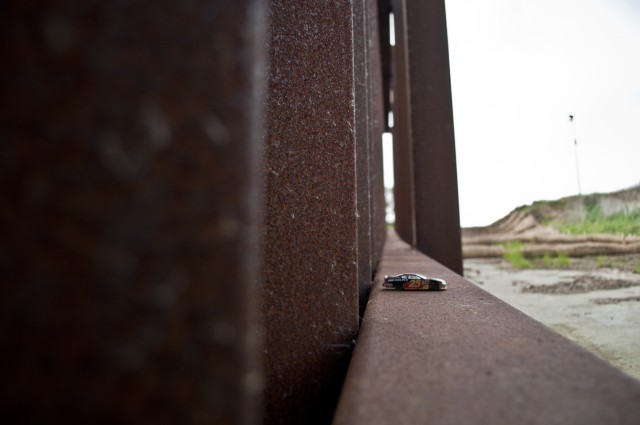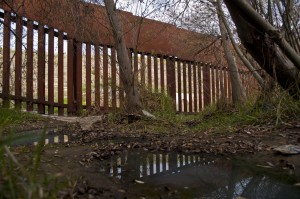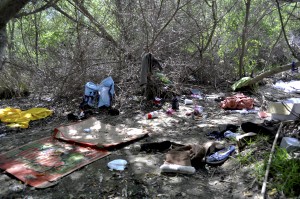In a small grove of trees sliced in two by the rough iron bars of the border wall, a little boy looking northward has left his car. Here, in La Cañada de Los Sauces, just a few hundred yards east of Friendship Park, migrants wait and watch for their opportunity to cross.
The natural features of this tiny grove, soaked with fetid standing water that can no longer flow easily through the canyon, gesture back to the degraded environmental conditions in these migrant families’ hometowns of Chiapas and Oaxaca.
What is easy to miss here is the natural link between the environment and migration: while families from southern Mexico migrate north seeking greater economic opportunities, many hundreds of thousands have been forced to migrate each year. Forced by the environmental destruction of their farmland, making it impossible to survive as they have for generations. Since the late 1970s, and accelerating after NAFTA, desertification–the degradation of normally fertile land–has prompted millions of Mexican farm families to move into urban areas, and many have migrated north into the United States.
How ironic then, that these migrants are forced to seek shelter in yet another vulnerable environment.
La Cañada de Los Sauces, popularly known as “Yogurt Canyon,” was yet another casualty of the U.S.-Mexico border wall. The wall disrupts a natural drainage system and bisects the small but ecologically significant canyon, declared in 2010 a conservation area by the XIX Ayuntamiento de Tijuana. Like the Tijuana Estuary directly to the north, La Cañada de Los Sauces is a space of rich biodiverity. In the northern section of the gorge alone, 67 species of plants have been identified, including several species of willow, rock rose, and elements of both coastal sage scrub and maritime chaparral. Hidden in the thick brush are 23 species of birds, and mammals, including the bat, raccoon, several species of gulls, the tildillo, some predators such as peregrine falcon, osprey and owls. The canyon extends from the border wall southward all the way to Paseo Playas de Tijuana, the main road entering Playas from Calle Seguda/Benito Juarez to the east and is considered a valuable visual and ecological resource for Tijuana and the binational region.
The war against nature was so difficult that the wall & culvert system was built & rebuilt twice by U.S. contractors, paid for by U.S. taxpayers. The wall was recently reinforced (November 2011-January 2012) with the same border wall panels used on Tecate Peak and Otay Mountain Wilderness.
Yet thanks to collaborative work by environmental organizations in Tijuana and San Diego, families from southern Mexico may soon join hands with Tijuanenses and Estadounidenses to enjoy the pleasures of La Cañada de Los Sauces. Groups like Tijuana Calidad de Vida and Proyecto Fronterizo de Educación Ambiental are working with San Diego binational environmental organizations like WildCoast/CostaSalvaje and Border Encuentro to clean canyons, protect the ocean water & beaches, and cultivate a binational garden of native plants along the border wall.
With more effort to protect flourishing and healthy environments on the border and in southern Mexico, the dangerous trip to El Norte may lose its appeal. Rather than migrate, families may be able to enjoy the right stay home.



